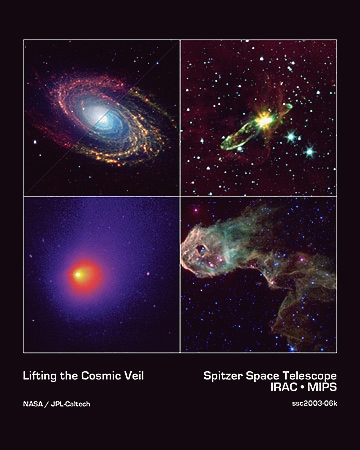
First pictures of SIRTF have been released on December, 18th 2003 and the telescope given the new name of Spitzer Space Telescope
At the opening ceremony for the work of the Space Infrared Space Infrared Telescope Facility (SIRTF), the telescope has been re-named the "Spitzer Space Telescope". Dr. Lyman Spitzer Jr. worked at Princeton University for 50 years and was the first to propose, in 1946, to put telescopes into orbit ("Astronomical Advantages of an Extra-Terrestrial Observatory"). He was the driving force behind NASA two first space observatories (the Orbiting Astronomical Observatory in 1968, Copernicus in 1972) and his efforts eventually led to Hubble. Lyman Spitzer, Jr. passed away on March 31, 1997 at the age of 82
The Spitzer Space Telescope was launched on August, 25th, 2003. It is the fourth of NASA large space observatories and it is aimed to study the Universe in the infrared. It is thus complementing the Hubble Space Telescope (visible light), the Chandra X-ray Observatory (X-rays), and the already de-orbited Compton Gamma Ray Observatory (gamma rays). Its sensors will be looking deep into obscuring clouds
 click for a larger image picture courtesy NASA/JPL-Caltech
click for a larger image picture courtesy NASA/JPL-Caltech
Clockwise on the above picture, first four released images are: M81 showing star formation regions; a new born Herbig-Haro (HH) star ejecting a bipolar outflow; comet Schwassmann-Wachmann I (P/SW-1); and protostars and new born stars inside a radiation-shaped dark globule. Spitzer pictures clearly bring new details about stars and planetary formation and are good examples of pictures the Spitzer Space Telescope will further bring to life
Spitzer Space Telescope is managed for NASA by JPL and science operations are conducted at the Spitzer Science Center at the California Institute of Technology, Pasadena
more details, more pictures at the official site
Website Manager: G. Guichard, site 'Amateur Astronomy,' http://stars5.6te.net. Page Editor: G. Guichard. last edited: 12/28/2010. contact us at ggwebsites@outlook.com